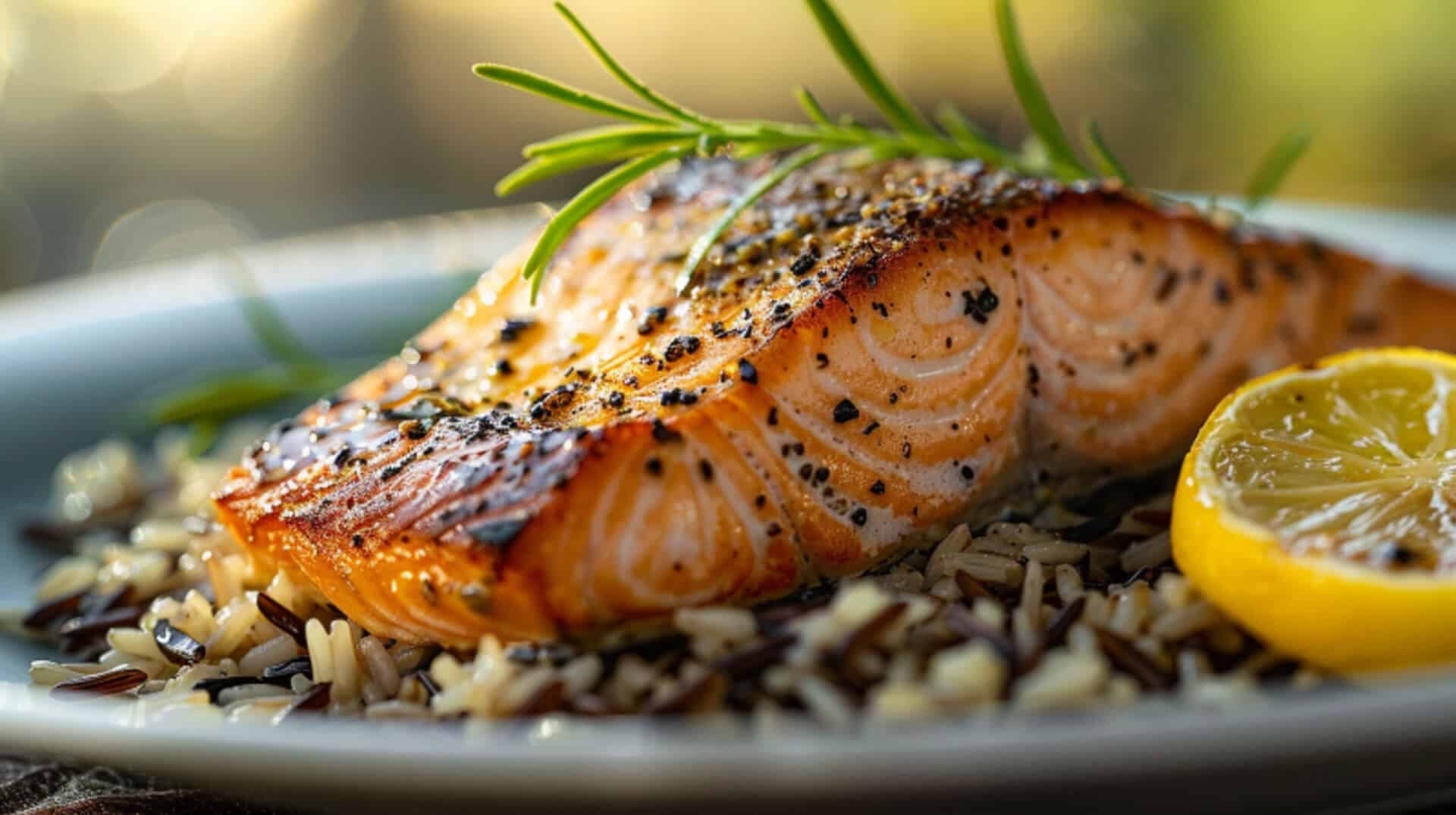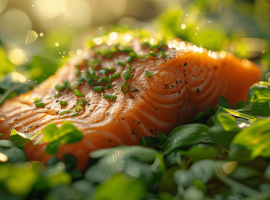Phosphorus in Aquatic Nutrition: Its Significance in the Human Diet
Phosphorus, a pivotal mineral in the human body, plays a crucial role in maintaining bone strength and cardiovascular health. It is a component of adenosine triphosphate (ATP), the molecule that stores the energy we need for just about everything we do. Phosphorus also contributes to the structural integrity of cell membranes and the synthesis of DNA and RNA, underscoring its importance in cell formation and function.
Contribution to Bone and Cardiovascular Health
The intake of phosphorus from fish is particularly beneficial as it aids in the mineralization of bones and teeth, acting in concert with calcium to bolster skeletal strength. Moreover, phosphorus is involved in maintaining a regular heartbeat and facilitating vascular contraction and dilation, which are vital for cardiovascular health.
Impact on Energy Levels and Cell Formation
Phosphorus-rich diets, inclusive of certain fish, enhance energy levels by supporting the creation and storage of energy in the body’s cells. This is essential for the metabolism of proteins, fats, and carbohydrates, ensuring that the body’s energy supply is efficiently utilised and replenished.
Variability Among Fish Types
The phosphorus content in fish can vary significantly, with certain types of oily fish, shellfish, and white fish being particularly rich sources. Oily fish such as salmon, mackerel, and herring are known for their higher phosphorus content, while white fish like cod and haddock offer moderate amounts. Shellfish, including shrimp and scallops, also contribute to phosphorus intake, though levels can fluctuate based on the marine environment and the species’ diet.
High-Phosphorus Fish: A Nutritional Guide

When seeking to enhance your diet with phosphorus-rich fish, it’s essential to know which varieties offer the most of this vital mineral. Phosphorus plays a pivotal role in maintaining bone health and energy levels, and certain fish are particularly abundant in this nutrient.
Oily Fish Versus White Fish: Phosphorus Content
Oily fish, such as salmon, mackerel, and sardines, are renowned for their high phosphorus content. These fish not only provide omega-3 fatty acids but also serve as excellent sources of phosphorus, which is crucial for bone health and energy metabolism. In contrast, white fish like cod and haddock still offer phosphorus but in lower quantities.
Shellfish: Phosphorus Levels
Shellfish, including shrimp, clams, and scallops, also contribute significant amounts of phosphorus to your diet. For instance, three ounces of cooked scallops can provide up to 10% of the daily recommended phosphorus intake.
Verifying Phosphorus Content
To ensure you’re selecting fish with the highest phosphorus content, consider consulting nutrient ranking tools and official dietary sources. These resources often provide detailed information on the phosphorus levels in various fish species, allowing you to make informed choices. Additionally, labels on packaged seafood can offer insight into the mineral content, helping you to maintain a balanced and phosphorus-rich diet.
Dietary Reference Intakes for Phosphorus

Understanding the dietary reference intakes (DRIs) for phosphorus is crucial for maintaining optimal health. Adults require about 700 milligrammes of phosphorus daily, which can be easily met through a balanced diet including phosphorus-rich fish.
Balancing Phosphorus Intake
To balance your phosphorus intake, it’s advisable to combine fish with other dietary sources of phosphorus such as dairy, nuts, and whole grains. This ensures a well-rounded intake of nutrients while preventing excessive phosphorus consumption, which can be particularly important for individuals with kidney disease.
Health Benefits of Adequate Phosphorus
Meeting the recommended phosphorus intake is associated with numerous health benefits. Phosphorus is essential for the formation of bones and teeth, DNA synthesis, and energy production. It also plays a vital role in muscle and nerve function.
Phosphorus Interaction with Other Nutrients
Phosphorus interacts synergistically with other minerals and vitamins, such as calcium and vitamin D, to enhance bone health. However, maintaining the right balance is key, as excessive phosphorus can inhibit calcium absorption. It’s important to consider the interplay of these nutrients to optimise their benefits.
Maximising Phosphorus Retention in Fish Through Cooking Methods

Cooking Techniques and Phosphorus Content
The method by which fish is cooked can influence the retention of phosphorus. Grilling, baking, and steaming are methods that preserve most of the phosphorus content. On the other hand, boiling fish can cause some phosphorus to leach into the water, which is then often discarded.
Enhancing Phosphorus Absorption
Marinating fish in acidic solutions like lemon juice or vinegar before cooking may enhance the bioavailability of phosphorus, making it easier for your body to absorb. However, the overall effect on phosphorus content is minimal, so these methods can be used without significantly altering phosphorus levels.
Best Practices for Preparing Phosphorus-Rich Fish
To maximise phosphorus intake from fish, it is recommended to use cooking methods that retain the fish’s natural juices, where phosphorus is present. Baking or broiling fish in its own juices not only preserves phosphorus but also other nutrients.
The Effect of Overcooking on Phosphorus Levels
While overcooking can affect the texture and flavour of fish, it does not significantly reduce the phosphorus content. However, prolonged cooking at high temperatures can degrade some vitamins and minerals, so it is advisable to cook fish just until it reaches the proper internal temperature.
Phosphorus Management in Kidney Disease

For individuals with kidney disease, managing phosphorus intake is critical due to the kidneys’ reduced ability to philtre and remove excess phosphorus from the blood. Elevated phosphorus levels can lead to serious health issues, including bone and cardiovascular problems.
Risks of High Phosphorus Intake for Kidney Conditions
Excessive phosphorus can result in hyperphosphatemia, a condition where phosphate levels in the blood are abnormally high, posing risks such as calcification of tissues and further impairment of kidney function. Therefore, monitoring and managing phosphorus intake is imperative for those with kidney conditions.
Kidney-Friendly Diets and Phosphorus
Kidney-friendly diets aim to maintain phosphorus levels within a safe range. This involves selecting fish and other foods with lower phosphorus content and being mindful of portion sizes. Dietitians often recommend specific dietary plans tailored to individual needs to ensure proper phosphorus management.
Alternatives for Limited Phosphorus Intake
For those required to limit phosphorus, alternatives include fish with lower phosphorus content or consuming smaller portions of phosphorus-rich fish. It’s also beneficial to pair these fish with foods that can help balance phosphorus levels, such as those rich in calcium. Consulting with healthcare providers for personalised advice is always recommended.
Sustainable Seafood: Phosphorus Content and Environmental Impact

The Influence of Sustainable Fishing on Phosphorus Intake
Choosing sustainable seafood is not only an environmentally responsible decision but also impacts the phosphorus content available to consumers. Sustainable fishing practices ensure that fish populations and their habitats are preserved, which in turn maintains the natural phosphorus levels in seafood.
Marine Ecosystems and Phosphorus Levels
Marine ecosystems play a crucial role in the phosphorus content of fish. Nutrient-rich waters support the growth of phytoplankton, which is the foundation of the aquatic food web. Overfishing disrupts these ecosystems, potentially altering the phosphorus balance and affecting the nutritional value of fish.
Making Environmentally Responsible Seafood Choices
To make environmentally responsible choices for high-phosphorus fish, consumers should:
- Look for certifications and labels indicating sustainable practices.
- Choose species that are not overfished or harvested from well-managed stocks.
- Support local fisheries that engage in responsible fishing methods.
Overfishing and Its Effects on Phosphorus Levels
Overfishing can lead to a decrease in fish populations, which affects the entire marine food web and can result in lower phosphorus levels in the remaining seafood. By choosing sustainable options, consumers help protect the delicate balance of marine ecosystems and ensure the continued availability of phosphorus-rich seafood.
Comparing Phosphorus in Wild and Farmed Fish

The phosphorus content in fish can vary significantly between wild and farmed sources due to differences in diet and living conditions.
Factors Influencing Phosphorus Levels
- Diet: Farmed fish are often fed a controlled diet that may be fortified with phosphorus, while wild fish consume a natural diet from their environment.
- Environment: The mineral composition of the water in which fish live can affect their phosphorus content. Farmed fish environments can be managed to optimise conditions, potentially leading to higher phosphorus levels.
Health Considerations for Farmed Fish
- Feed Quality: The quality of feed and the use of supplements in aquaculture can lead to higher phosphorus content in farmed fish. However, this does not necessarily translate to health concerns if consumed as part of a balanced diet.
- Contaminants: Both wild and farmed fish can contain contaminants that affect health, but these are not directly related to phosphorus levels.
Making Informed Choices
Consumers should consider the following when selecting fish:
- Certifications: Look for sustainability certifications that indicate responsible farming practices.
- Nutritional Information: Check labels for phosphorus content when available, especially if managing conditions like kidney disease.
- Balance: Incorporate a variety of fish into your diet to balance nutrient intake, including phosphorus.
Essential Nutrients in Phosphorus-Rich Fish

Phosphorus-rich fish are a powerhouse of essential nutrients that are vital for maintaining good health. When you include these fish in your diet, you’re not only getting phosphorus but also a host of other beneficial nutrients.
Balancing Phosphorus with Omega-3s and Protein
- Omega-3 Fatty Acids: Many phosphorus-rich fish, such as salmon and mackerel, are also excellent sources of omega-3 fatty acids, which support heart and brain health.
- Protein: Fish is a lean source of high-quality protein, necessary for muscle repair and growth.
Risks of Nutrient Imbalance
An unbalanced nutrient profile, where one consumes too much phosphorus relative to other nutrients like calcium, can lead to mineral imbalances. This is particularly concerning for bone health, as it may contribute to osteoporosis.
Ensuring Adequate Phosphorus Without Excess
A varied diet is key to ensuring adequate phosphorus intake without excess. Including a range of phosphorus-rich fish alongside other foods high in calcium and vitamin D can help maintain the necessary balance for optimal health. It’s also important to consider the preparation of fish to retain its nutrient profile, as certain cooking methods may diminish nutrient content.
Utilising Visual Data to Understand Phosphorus in Fish

Visual data, such as charts and infographics, can significantly enhance your understanding of the phosphorus content in various fish. These tools distil complex nutritional information into easily digestible visuals, aiding in the selection of phosphorus-rich seafood.
Types of Visuals for Nutritional Information
- Bar Charts: Display the phosphorus content across different fish species, allowing for quick comparisons.
- Pie Charts: Illustrate the proportion of phosphorus in a single serving of fish relative to the daily recommended intake.
- Infographics: Combine images of fish with overlaid text highlighting their phosphorus content, serving sizes, and health benefits.
Planning a Phosphorus-Rich Diet with Visual Aids
Visual tools can be instrumental in meal planning. By providing a clear representation of phosphorus levels, they help you to:
- Ensure a balanced intake of phosphorus.
- Diversify your seafood choices to meet dietary needs.
- Understand the impact of portion sizes on phosphorus consumption.
Sources for Reliable Phosphorus Content Data
For accurate and up-to-date visual data on phosphorus levels in seafood, consider the following resources:
- Nutrition Databases: Websites like the USDA’s FoodData Central offer comprehensive nutrient profiles for various fish.
- Health Organisations: Entities such as the American Heart Association provide guidelines and visuals on nutrient-rich foods, including seafood.
- Dietary Apps: Many mobile applications feature visual tools to track and plan your nutrient intake, including phosphorus.
Professional Guidance on Phosphorus Intake from Fish

Nutritionists and dietitians recognise the importance of phosphorus in the diet and advocate for the inclusion of phosphorus-rich fish as part of a balanced nutritional plan. They emphasise the role of phosphorus in bone health, energy production, and cellular repair, and recommend fish as a preferred source due to its additional health benefits, such as omega-3 fatty acids.
Latest Research on Phosphorus and Health
Recent studies underscore the necessity of maintaining adequate phosphorus levels and the risks associated with both deficiency and excess. Experts are particularly attentive to the needs of individuals with kidney disease, for whom phosphorus intake must be carefully managed.
Incorporating High-Phosphorus Fish into Meals
Professionals suggest the following strategies for including high-phosphorus fish in your diet:
- Diversify Your Seafood Selection: Incorporate a variety of phosphorus-rich fish to enjoy different flavours and textures while managing nutrient intake.
- Consider Cooking Methods: Opt for cooking methods that preserve the nutrient content, such as grilling or baking.
- Balance with Other Foods: Pair fish with foods high in calcium to maintain mineral balance and support bone health.
By following these guidelines, you can confidently include the right amount of phosphorus-rich fish in your meals for optimal health benefits.
Incorporating Phosphorus-Rich Fish into Your Diet

Incorporating phosphorus-rich fish into your diet can be both simple and delicious. Here are practical tips to ensure you’re getting the benefits of phosphorus through your meals.
Simple Recipes for Phosphorus-Rich Fish
- Grilled Mackerel: Season fresh mackerel fillets with lemon juice and herbs, then grill to perfection.
- Baked Salmon: Wrap salmon in foil with olive oil and your choice of spices, baking until flaky.
- Sardine Spread: Mash canned sardines with avocado, lemon juice, and salt for a quick, nutrient-packed snack.
Meal Planning for Adequate Phosphorus Intake
- Weekly Fish Meals: Aim to include fish high in phosphorus, like salmon or trout, in your meal plan at least twice a week.
- Balanced Portions: Serve fish with a side of leafy greens or whole grains to complement the phosphorus content.
Creative Dietary Additions
- Fish Tacos: Use grilled fish as a filling for tacos, topped with fresh salsa for an extra nutrient boost.
- Seafood Salads: Add cooked, chilled shrimp or scallops to your salads for a refreshing, phosphorus-rich meal.
Assistance from “Frozen Fish Direct”
- Quality Selection: “Frozen Fish Direct” offers a variety of frozen-at-sea fish, ensuring you receive the freshest, high-phosphorus options.
- Convenient Delivery: With door delivery service, incorporating phosphorus-rich fish into your diet becomes effortless.
- Diverse Options: Explore over 200 items to keep your meals interesting and nutritionally balanced.
Tailoring Phosphorus Intake Through Seafood Selection

Selecting the right fish is pivotal for optimising phosphorus intake. Individuals should consider their health objectives when choosing seafood, as phosphorus needs can vary based on age, lifestyle, and medical conditions.
Personalising Fish Choices for Health Goals
- Assess Dietary Needs: Determine your phosphorus requirements by consulting with a healthcare provider, especially if you have specific health conditions like kidney disease.
- Diversify Seafood: Include a variety of phosphorus-rich fish in your diet, such as salmon, mackerel, and trout, to benefit from their differing nutrient profiles.
Future Research Directions
- Nutrient Absorption Studies: Ongoing research is needed to understand how the body absorbs phosphorus from different fish species.
- Environmental Impacts: Studies on how changes in marine ecosystems affect the phosphorus content of fish will be valuable for future dietary recommendations.
Role of “Frozen Fish Direct” in a Phosphorus-Conscious Diet
- Quality Assurance: “Frozen Fish Direct” ensures that the fish retains its nutrient content through proper freezing techniques.
- Convenient Access: The company provides a diverse selection of phosphorus-rich fish, making it easier for you to meet your dietary needs.
- Educational Resources: They offer information on the phosphorus content of their products, helping you make informed decisions.









